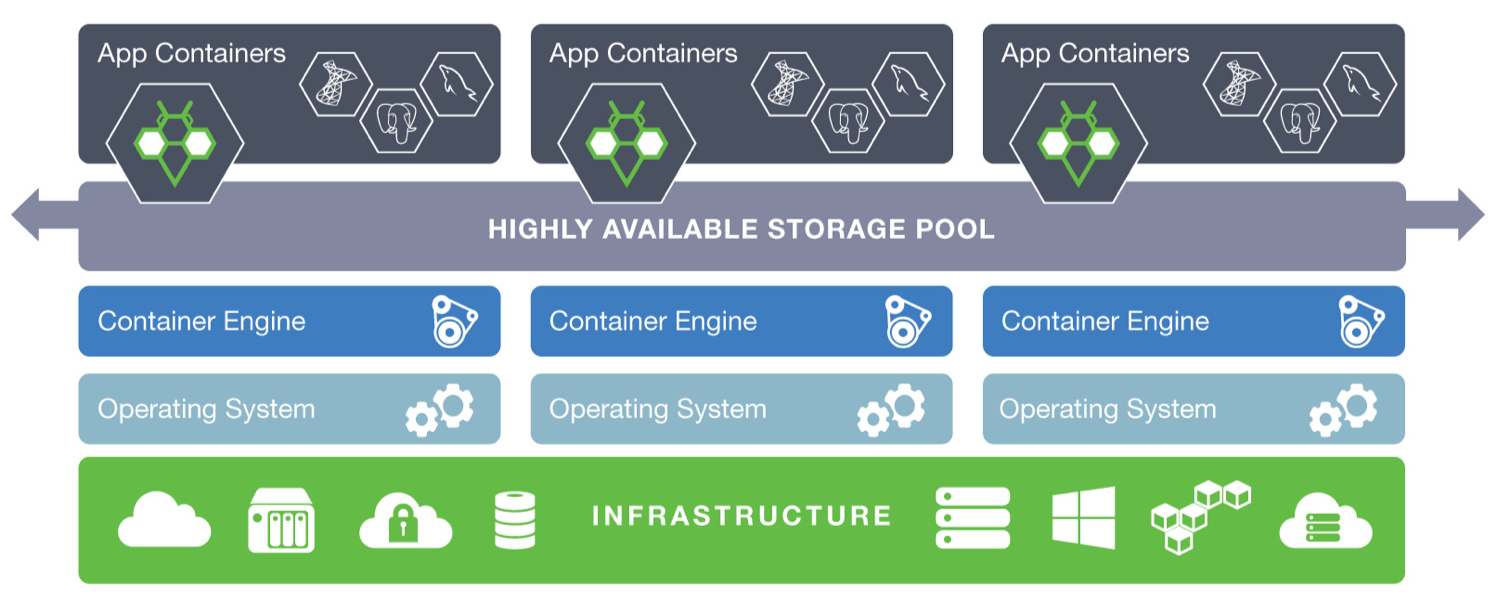StorageOS Components
StorageOS is a software-defined storage platform for running stateful applications in Kubernetes.
Fundamentally, StorageOS uses the storage attached to the nodes in the
StorageOS cluster to create and present virtual volumes into containers. Space
on the host is consumed from the mount point /var/lib/storageos/data, so it
is therefore recommended that disk devices are used exclusively for StorageOS,
as described in Managing Host Storage
StorageOS is agnostic to the underlying storage and runs equally well on bare metal, in virtual machines or on cloud providers.

Read about the cloud native storage principles behind StorageOS.
StorageOS on Kubernetes
StorageOS is architected as a series of containers that fulfil separate, discrete functions.
Links where appropriate have been given to our open-source GitHub repo.
Responsible for the creation and maintenance of the StorageOS cluster. This operator is primarily responsible for ensuring that all the relevant applications are running in your cluster.
- StorageOS Controlplane
Responsible for monitoring and maintaining the state of volumes and nodes in the cluster. The Controlplane and the Dataplane run together in a single container, managed by a daemonset. The Controlplane works with etcd to maintain state consensus in your cluster.
- StorageOS Dataplane
Responsible for all I/O path related tasks; reading, writing, compression and caching.
- StorageOS Scheduler
Responsible for scheduling applications on the same node as an application’s volumes. StorageOS uses a custom Kubernetes scheduler to handle pod placement, ensuring that volumes are deployed on the same nodes as the relevant workloads as often as possible.
Responsible for registering StorageOS with Kubernetes as a CSI driver. It is necessary because the internal persistent volume controller running in Kubernetes controller-manager does not have any direct interfaces to CSI drivers. It monitors PVC objects created by users and creates/deletes volumes for them.
Acts as a middle-man between various APIs. It has all the capabilities of a Kubernetes Operator and is also able to communicate with the StorageOS control plane API. This application handles typical operator tasks like labelling or removing nodes from StorageOS when removed from the Kubernetes. It is continually monitoring the state of the cluster and moving it towards the desired state when necessary.
StorageOS is deployed by the StorageOS Cluster Operator. In Kubernetes, the StorageOS Controlplane and Dataplane are deployed in a single pod managed by a daemonset. This daemonset runs on every node in the cluster that will consume or present storage. The Scheduler, CSI helper, Cluster Operator and API Manager run as separate pods and are controlled as deployments.
StorageOS is designed to feel familiar to Kubernetes and Docker users. Storage
is managed through standard StorageClasses and PersistentVolumeClaims, and
features are controlled by
Kubernetes-style labels and selectors, prefixed with storageos.com/. By
default, volumes are cached to improve read performance and compressed to
reduce network traffic.
Any pod may mount a StorageOS virtual volume from any node that is also running StorageOS, regardless of whether the pod and volume are collocated on the same node. Therefore, applications may be started or restarted on any node and access volumes transparently.